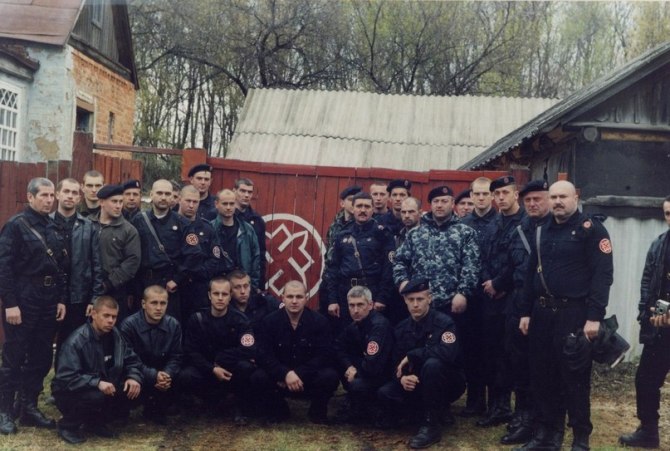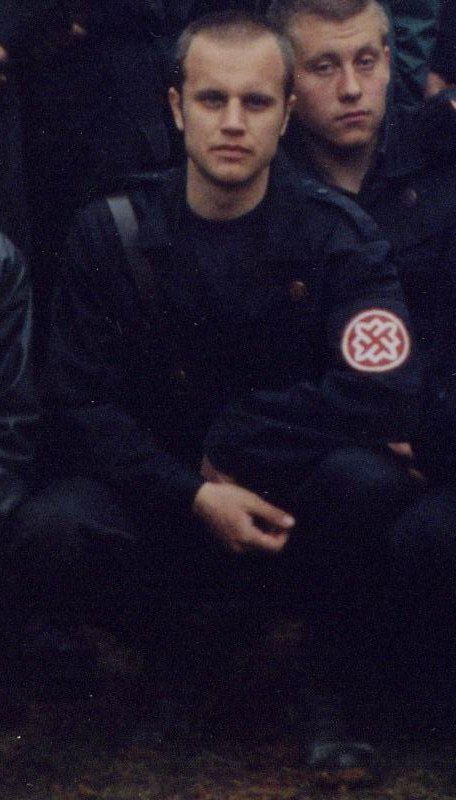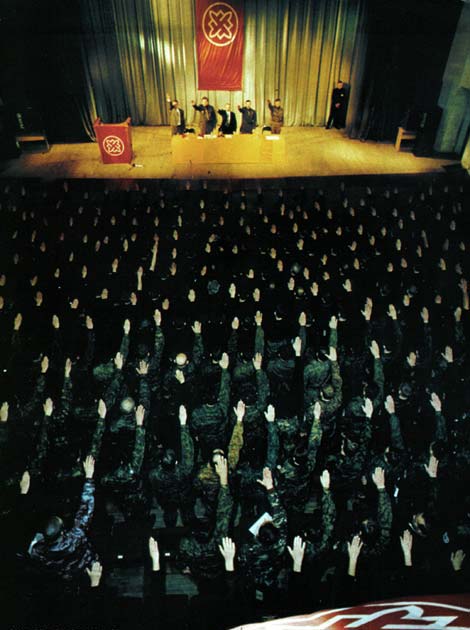
Trying to abolish or replace the nation-state is almost certain to produce more evils than it deters.
By John O'Sullivan
Incessant "antifascist" propaganda from
Moscow, baseless claims of attacks against Russians in Ukraine,
incitement of Russian-speakers in eastern Ukraine, Russian troops
without insignia seizing official buildings in Crimea, a stage-managed
illegal plebiscite there and then its annexation by Russia, assurances
from President
Vladimir Putin
that he has no further territorial designs in Europe (though,
alas, he may be forced to intervene elsewhere to protect ethnic
Russians)—yes, it all has the disturbing ring of the 1930s.
Isn't this where nationalism leads—to fascism and war?
That
is a common interpretation of Europe's recent crises. It is also,
coincidentally, Mr. Putin's interpretation of events in Ukraine, which
he blames on neo-fascist followers of the nationalist leader
Stepan Bandera,
who was murdered by the KGB in 1959. But this view is really too
simple by half.
Nationalists are
certainly implicated in the Ukraine crisis, but more as victims than
perpetrators. The crisis began as an attempt by Moscow to rescue its
stillborn concept of a Eurasian Economic Union by forcing Ukraine to
join it and to reject associate membership in the European Union.
Mr.
Putin, who isn't a nationalist (see below) but the ruler of a shaky
multinational empire hostile to nationalism, sparked off the crisis by
closing Russia's borders to Ukraine's agricultural exports. He did so to
compel a reluctant President
Viktor Yanukovych
to abandon the more popular EU option.
The
Ukrainian government, encouraged by Mr. Putin, unified the assorted
democrats, nationalists and activists of the left and the right who
protested this move by firing indiscriminately on them. Mr. Yanukovych's
power crumbled almost visibly; he fled; and a new Ukrainian government
that includes nationalists took over.
Nationalism
was thus one impulse in this general movement. Others were love of
freedom, desire for a more democratic system, economic hopes for greater
prosperity through ties to Western Europe and simple human decency. The
Ukrainians inspired by these aims have just sustained an (inevitable)
defeat in Crimea, but they still govern most of Ukraine, which is now
escaping from Moscow's post-Soviet institutions. While that remains the
case, Mr. Putin has suffered a reverse overall.
If
Ukrainian nationalists have been reactive, even victimized, in this
crisis, what about Mr. Putin himself? His actions have certainly been
objectionable—ruthless, aggressive, deceitful, illegal, repressive,
subversive. But to describe them as "nationalist" is to reduce the
concept of nationalism to a politics of aggressive self-assertion. There
is no reason to suppose that nations and nation-states are more prone
to indulge in such folly than are federations, empires or states founded
on non-national principles.
Mr. Putin
has indeed acted ruthlessly of late, but he has done so in the service
of what he sees as clear state or even personal interests, not from a
commitment to Russian peoplehood.
The
history of the 1930s is instructive for making the necessary
distinctions here. World War II began as the result of a conspiracy by
Hitler and Stalin—the Nazi-Soviet Pact—to invade Poland and divide
Eastern Europe and the Baltic states between them. Nazi Germany was a
state built upon the ideology of racial nationalism (which places race
above nationhood), the Soviet Union upon the ideology of proletarian
internationalism (which rejects nationalism entirely). Both acted far
more brutally and unrestrainedly than any conventional nation-state of
the period.
Besides, today's Russian
Federation is itself not a nation-state but an empire. Mr. Putin's
conduct of the crisis, in addition to being aggressive, might best be
described as imperialist or neo-imperialist, not nationalist. We should
not illegitimately associate the nation-state with crimes that aren't
uniquely nationalist and may even be less likely to be committed by
stable nation-states.
This matters
because nationalism is an increasingly necessary word that is too often
misused as a term of abuse. Nationalisms and nationalist movements are
popping up all over Europe. These can take very different forms: left,
right and ambivalent. Some are straightforward secessionist movements,
like the nationalist parties in Scotland and Catalonia, striving to
establish new states rooted in historic nations. Others are movements
resisting further integration of their existing nation-states into the
European Community, such as the True Finns party in Finland and the U.K.
Independence Party in Britain.
Still
others want to protect the nation and its distinctive political spirit
(the National Front in France), or the welfare state (the Danish
People's Party in Denmark) or "liberal values" (the Party of Freedom led
by
Geert Wilders
in Holland) that each feels is threatened by mass immigration.
Even the mercifully cautious Germans have the Alternative for Germany
party, which, though not avowedly nationalist, emits a distinctively
postwar German anti-Euro economic nationalism—and should probably be
renamed the Alliance of Patriotic Bankers.
Most of these parties, which didn't
exist 20 years ago, are now represented in Europe's parliaments. They
are expected to do well in May's elections. They probably won't win
power or enter government, but they force mainstream parties to deal
with such issues as the loss of national sovereignty.
In
the eyes of Europe's various political and cultural establishments—what
the British call the Great and the Good—none of this should be
happening. It is akin to water running uphill. For several decades now,
we have heard from these precincts that the nation-state is on its way
out, losing power upward to supranational institutions and downward to
organized minority groups. Behind their hands, the critics of resurgent
nationalism murmur that it is nothing but xenophobia, authoritarianism
or even fascism, in folkloric drag. They see Europe's rising nationalist
parties as the preserve of bitter losers or those in the grip of
nostalgia.
Herman Van Rompuy,
the president of the European Council, expressed this view
perfectly in 2010 when he announced for the umpteenth time that the
nation-state was dead, adding: "The biggest enemy of Europe today is
fear; fear leads to egoism, egoism leads to nationalism, and nationalism
leads to war."
This pronouncement
didn't foresee Mr. Putin's recent actions. But it illustrates nicely how
Europe's political elites see events like the Ukraine crisis in the
distorting mirror of anti-nationalism. This view persuades them to
consider nationalism a threat, but a dying one. And it is, quite simply,
wrong on both counts.
A practical
refutation of this view lies in the fact that there are more
nation-states in the world today than ever before. They have multiplied
since 1945 in two great leaps forward: the decolonization period of the
1950s and 1960s, and the years following the dissolution of communism in
1989 and 1991. Some of these nations gained their independence, alas,
by war and revolution—Zimbabwe, Croatia, Bosnia, Kosovo. Others did so
by peaceful negotiation. Most former British colonies and Soviet
republics took this route, but the most significant example of it is the
"velvet divorce" that produced successful Czech and Slovak states.
This
upsurge of nationhood might be dismissed as a detour on the high road
to global governance if the establishment view of nationalism weren't so
absurdly crude. It elides vital distinctions and treats all forms of
national loyalty as if they were the most aggressive and exclusivist
type. In reality, the full spectrum of nationalist loyalties runs
roughly as follows: from Nazism, which is totalitarian racial
nationalism; to fascism, which is authoritarian and aggressive
nationalism; to ethnic nationalism, which is exclusivist, treating
ethnic minorities as second-class citizens (if that); to civic
nationalism, which opens full citizenship to all born in the national
territory in return for their loyalty to the nation and its
institutions; and finally, to patriotism, which is that same national
loyalty plus simple love of country—its scenery, its sights and sounds,
its characteristic architecture, its songs and poems, its people, its
wonderful familiarity.
Here, for
instance, is
George Orwell,
perhaps the most famous critic of nationalism, upon returning to
southern England from Spain: "Down here it was still the England I had
known in my childhood: the railway-cuttings smothered in wildflowers,
the deep meadows where the great shining horses browse and meditate, the
slow-moving streams bordered by willows, the green bosoms of the elms,
the larkspurs in the cottage gardens; and then the huge peaceful
wilderness of outer London, the barges on the miry river, the familiar
streets, the posters telling of cricket matches and Royal weddings, the
men in bowler hats, the pigeons in Trafalgar Square, the red buses, the
blue policemen—all sleeping the deep, deep sleep of England."
England
has changed since then, of course; men no longer wear bowler hats. But
it would be as absurd to condemn such a tender patriotism as likely to
lead to fascism as it would be to abstain from all interest in sex on
the grounds that it might lead to promiscuity. Ordinary people, attached
to reality as they must be to survive, feel exactly that sense of
absurdity when they hear statements like Mr. Van Rompuy's.
But
that hasn't hitherto affected their political behavior. Why have they
suddenly begun thinking and voting in line with such sentiments?
One
obvious reason is that all the ideological rivals to patriotism have
been largely discredited. Orwell pointed out that those who abandoned
patriotism generally adopted a more virulent ideological substitute. In
our day, the most obvious rival ideologies are Europeanism in Europe and
multiculturalism in the U.S., both of which seek to weaken national
patriotism to change the political character of their societies.
But neither of these creeds has yet become
more than a niche loyalty, even though they enjoy lavish official
support and the sympathy of those government officials, international
bureaucrats, NGO executives, "denationalized" corporate managers and
academics ambitious to be the vanguard of the new or transformed nation.
Old-fashioned patriotism survives, perhaps weakened by such defections,
but not seriously challenged. It remains in the shadows until tempted
into the open by a 9/11, or an anniversary of D-Day or the funeral of a
Margaret Thatcher.
It is then suddenly recognized as the sentiment of most of the nation.
Until
recently, those voters for whom patriotism and the national interest
were determining issues found comfortable homes in parties of both the
left and the right. But that has gradually ceased to be true.
As
parties of the left swapped their working-class identity for that of
middle-class liberalism, they began to think patriotism vulgar, cheap
and xenophobic. At the same time, mainstream parties of the right
drifted unthinkingly into a posture that treated nationalist and
socially conservative voters as somewhat embarrassing elderly relatives
whose views could be safely ignored. Party leaders reasoned that their
atavistic voters had nowhere else to go.
The
result can be seen most dramatically in Britain, where the U.K.
Independence Party, having secured its base among traditional
middle-class Tories, is now harvesting new votes from patriotic
blue-collar Laborites. But one can see similar outcomes throughout
Europe.
Another factor in this
resurgence is a change of intellectual fashion toward bigness. Fewer
people in all classes are still confident that the future belongs to the
big battalions. They have noticed that smaller states are likely to be
richer, easier to manage and closer to the people than larger states. As
the Economist magazine pointed out a few years ago: "Of the 10
countries with populations of over 100 [million], only the U.S. and
Japan are prosperous."
These economic
facts remove an important obstacle to secession. And if there ever was a
link between prosperity and bigness, it has been dissolved by free
trade and globalization, which ensure that the size of a nation need no
longer coincide with the size of the market open to it. At the same
time, a government can shrink to the size that its citizens find most
convenient to control.
The U.S. is the
exception to these rules—it is both large and prosperous—because its
federalism distributes power to states and localities, where it can be
better controlled. Switzerland is another example. Europe might imitate
America's success if it were to model itself on Switzerland and
distribute power downward. But the opposite is happening—in both Europe
and America.
A final brief argument is
perhaps the strongest: Nation-states are an almost necessary basis for
democracy. A common language and culture, a common allegiance to
national institutions, a common sense of destiny, all within a defined
territory, with equal rights for all citizens—these seem to be the
conditions that enable people with different opinions and interests to
accept political defeat and the passage of laws to which they strongly
object. There are a few exceptions to this rule—India, Switzerland—but
many more confirmations of it.
None of
these many considerations justify supporting nationalism as a universal
principle of statehood. There is no such principle. States rooted in
ideas as different as popular consent and the dynastic principle have
been handed down to us by history. Wholesale reconstruction of them is
utopian and nearly always fails. The best we can hope for is to improve
them by piecemeal reform along the grain of their history.
But
trying to abolish or replace the nation-state is almost certain to
produce more evils than it deters. The lesson of recent history is that
nationalism is here to stay—and that secure, stable and satisfied
nation-states are likely to want friendship with neighboring countries
rather than their conquest. Wise political leaders anxious for peace
will concentrate on shaping their people's nationalism into an amiable
patriotism rather than on submerging it in a new sovereignty and driving
it toward its darker manifestations.
Mr. O'Sullivan is director of the Danube Institute in Budapest and a senior fellow of the National Review Institute in New York.







